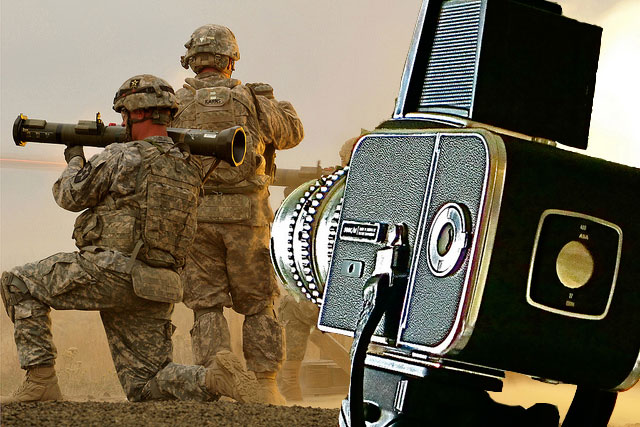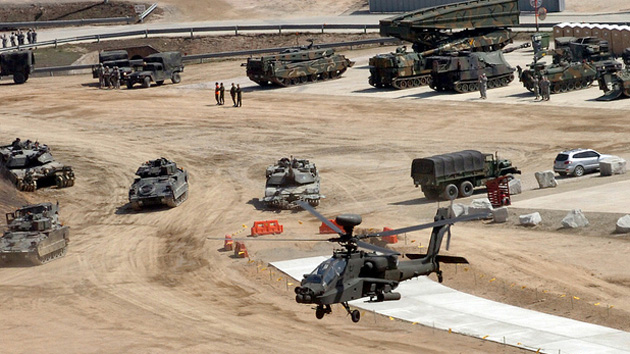
Soldiers:<a href="https://www.flickr.com/photos/dvids/6329841066/in/photolist-aDm6dN-puUaRT-7PukSP-7Pyjxu-7Pug2p-7PyeMb-aqvXpM-7Pumb4-a9kTU5-9fkoHz-7xmPYU-7NgxhP-ojhuEH-dkJKQa-8xsNxT-daCM22-dby5y9-6MU9md-8tqWwo-aqCRJ4-8rad4k-7fphbw-7RDSPf-7fphij-8CSWmd-8rdk7f-hn9X1g-9zVHGj-dfRq1X-8kvpxn-8EGA5n-57awsn-6TwG1A-eyQ3ML-7XA9nB-b9KHaz-7PumqK-7vbRbK-fqPZhe-fu6ZU4-6Sny9H-6Snyp6-nuxEs9-9zXhVN-a9pkFQ-8AWiRd-6EqFXq-fv7PyG-7fkjwK-5GG2f1">DVIDSHUB</a>/Flickr; Camera:<a href="https://www.flickr.com/photos/jarmandophotos/7119002043/in/photolist-edav6y-ed4Njn-edauvE-ed4Pjg-ed4NPn-edau6Q-gHH8J5-6XuBtA-9sRahx-6r9EZP-6pR1KK-5c57BW-bR5Khx-7wJ3sF-w1rfg-8uYY6S-3Fwu8q-3FwMZJ-7KDD2k-8uVTTM-8uYX7w-8uYXBh-8uVTqx-6T9pdo-6te9Kn-9kZVas-8uYX9q-8Wg64-haZFJ-6BucpX-9UseaM-9XALkm-9XABUU-8uYXCy-8uYX59-4HuZ7i-9nnsWk-5X6WbE-9XfYNM-phzFB8-6sd6kY-qy44Zw-hLPx9y-nkDeJz-cJJ8mQ-9UncDC-iv3PUD-7wJ3Wz-cfKwQU-bqwo1q">josue armando serrano</a>/Flickr
This story first appeared on the TomDispatch website.
In the age of the all-volunteer military and an endless stream of war zone losses and ties, it can be hard to keep Homeland enthusiasm up for perpetual war. After all, you don’t get a 9/11 every year to refresh those images of the barbarians at the airport departure gates. In the meantime, Americans are clearly finding it difficult to remain emotionally roiled up about our confusing wars in Syria and Iraq, the sputtering one in Afghanistan, and various raids, drone attacks, and minor conflicts elsewhere.
Fortunately, we have just the ticket, one that has been punched again and again for close to a century: Hollywood war movies (to which the Pentagon is always eager to lend a helping hand).American Sniper, which started out with the celebratory tagline “the most lethal sniper in US history” and now has the tagline “the most successful war movie of all time,” is just the latest in a long line of films that have kept Americans on their war game. Think of them as war porn, meant to leave us perpetually hyped up. Now, grab some popcorn and settle back to enjoy the show.
There’s Only One War Movie
Wandering around YouTube recently, I stumbled across some good old government-issue propaganda. It was a video clearly meant to stir American emotions and prepare us for a long struggle against a determined, brutal, and barbaric enemy whose way of life is a challenge to the most basic American values. Here’s some of what I learned: our enemy is engaged in a crusade against the West; wants to establish a world government and make all of us bow down before it; fights fanatically, beheads prisoners, and is willing to sacrifice the lives of its followers in inhuman suicide attacks. Though its weapons are modern, its thinking and beliefs are 2,000 years out of date and inscrutable to us.
Of course, you knew there was a trick coming, right? This little US government-produced film wasn’t about the militants of the Islamic State. Made by the US Navy in 1943, its subject was “Our Enemy the Japanese.” Substitute “radical Islam” for “emperor worship,” though, and it still makes a certain propagandistic sense. While the basics may be largely the same (us versus them, good versus evil), modern times do demand something slicker than the video equivalent of an old newsreel. The age of the Internet, with its short attention spans and heightened expectations of cheap thrills, calls for a higher class of war porn, but as with that 1943 film, it remains remarkable how familiar what’s being produced remains.
Like propaganda films and sexual pornography, Hollywood movies about America at war have changed remarkably little over the years. Here’s the basic formula, from John Wayne in the World War II-era Sands of Iwo Jima to today’s American Sniper:
- American soldiers are good, the enemy bad. Nearly every war movie is going to have a scene in which Americans label the enemy as “savages,” “barbarians,” or “bloodthirsty fanatics,” typically following a “sneak attack” or a suicide bombing. Our country’s goal is to liberate; the enemy’s, to conquer. Such a framework prepares us to accept things that wouldn’t otherwise pass muster. Racism naturally gets a bye; as they once were “Japs” (not Japanese), they are now “hajjis” and “ragheads” (not Muslims or Iraqis). It’s beyond question that the ends justify just about any means we might use, from the nuclear obliteration of two cities of almost no military significance to the grimmest sort of torture. In this way, the war film long ago became a moral free-fire zone for its American characters.
- American soldiers believe in God and Country, in “something bigger than themselves,” in something “worth dying for,” but without ever becoming blindly attached to it. The enemy, on the other hand, is blindly devoted to a religion, political faith, or dictator, and it goes without saying (though it’s said) that his God—whether an emperor, Communism, or Allah—is evil. As one critic put it back in 2007 with just a tad of hyperbole, “In every movie Hollywood makes, every time an Arab utters the word Allah… something blows up.”
- War films spend no significant time on why those savages might be so intent on going after us. The purpose of American killing, however, is nearly always clearly defined. It’s to “save American lives,” those over there and those who won’t die because we don’t have to fight them over here. Saving such lives explains American war: in Kathryn Bigelow’s The Hurt Locker, for example, the main character defuses roadside bombs to make Iraq safer for other American soldiers. In the recent World War II-themed Fury, Brad Pitt similarly mows down ranks of Germans to save his comrades. Even torture is justified, as in Zero Dark Thirty, in the cause of saving our lives from their nightmarish schemes. In American Sniper, shooter Chris Kyle focuses on the many American lives he’s saved by shooting Iraqis; his PTSD is, in fact, caused by his having “failed” to have saved even more. Hey, when an American kills in war, he’s the one who suffers the most, not that mutilated kid or his grieving mother—I got nightmares, man! I still see their faces.
- Our soldiers are human beings with emotionally engaging backstories, sweet gals waiting at home, and promising lives ahead of them that might be cut tragically short by an enemy from the gates of hell. The bad guys lack such backstories. They are anonymous fanatics with neither a past worth mentioning nor a future worth imagining. This is usually pretty blunt stuff. Kyle’s nemesis in American Sniper, for instance, wears all black. Thanks to that, you know he’s an insta-villain without the need for further information. And speaking of lack of a backstory, he improbably appears in the film both in the Sunni city of Fallujah and in Sadr City, a Shia neighborhood in Baghdad, apparently so super-bad that his desire to kill Americans overcomes even Iraq’s mad sectarianism.
- It is fashionable for our soldiers, having a kind of depth the enemy lacks, to express some regrets, a dollop of introspection, before (or after) they kill. In American Sniper, while back in the US on leave, the protagonist expresses doubts about what he calls his “work.” (No such thoughts are in the book on which the film is based.) Of course, he then goes back to Iraq for three more tours and over two more hours of screen time to amass his 160 “confirmed kills.”
- Another staple of such films is the training montage. Can a young recruit make it? Often he is the Fat Kid who trims down to his killing weight, or the Skinny Kid who muscles up, or the Quiet Kid who emerges bloodthirsty. (This has been a trope of sexual porn films, too: the geeky looking guy, mocked by beautiful women, who turns out to be a superstar in bed.) The link, up front or implied, between sexuality, manhood, and war is a staple of the form. As part of the curious PTSD recovery plan he develops, for example, Kyle volunteers to teach a paraplegic vet in a wheelchair to snipe. After his first decent shot rings home, the man shouts, “I feel like I got my balls back!”
- Our soldiers, anguished souls that they are, have no responsibility for what they do once they’ve been thrown into our wars. No baby-killers need apply in support of America’s post-Vietnam, guilt-free mantra, “Hate the war, love the warrior.” In the film First Blood, for example, John Rambo is a Vietnam veteran who returns home a broken man. He finds his war buddy dead from Agent Orange-induced cancer and is persecuted by the very Americans whose freedom he believed he had fought for. Because he was screwed over in The ‘Nam, the film gives him a free pass for his homicidal acts, including a two-hour murderous rampage through a Washington State town. The audience is meant to see Rambo as a noble, sympathetic character. He returns for more personal redemption in later films to rescue American prisoners of war left behind in Southeast Asia.
- For war films, ambiguity is a dirty word. Americans always win, even when they lose in an era in which, out in the world, the losses are piling up. And a win is a win, even when its essence is one-sided bullying as in Heartbreak Ridge, the only movie to come out of the ludicrous invasion of Grenada. And a loss is still a win in Black Hawk Down, set amid the disaster of Somalia, which ends with scenes of tired warriors who did the right thing. Argo—consider it honorary war porn—reduces the debacle of years of US meddling in Iran to a high-fiving hostage rescue. All it takes these days to turn a loss into a win is to zoom in tight enough to ignore defeat. In American Sniper, the disastrous occupation of Iraq is shoved offstage so that more Iraqis can die in Kyle’s sniper scope. In Lone Survivor, a small American “victory” is somehow dredged out of hopeless Afghanistan because an Afghan man takes a break from being droned to save the life of a SEAL.
In sum: gritty, brave, selfless men, stoic women waiting at home, noble wounded warriors, just causes, and the necessity of saving American lives. Against such a lineup, the savage enemy is a crew of sitting ducks who deserve to die. Everything else is just music, narration, and special effects. War pornos, like their oversexed cousins, are all the same movie.
A Fantasy That Can Change Reality
But it’s just a movie, right? Your favorite shoot-em-up makes no claims to being a documentary. We all know one American can’t gun down 50 bad guys and walk away unscathed, in the same way he can’t bed 50 partners without getting an STD. It’s just entertainment. So what?
So what do you, or the typical 18-year-old considering military service, actually know about war on entering that movie theater? Don’t underestimate the degree to which such films can help create broad perceptions of what war’s all about and what kind of people fight it. Those lurid on-screen images, updated and reused so repetitively for so many decades, do help create a self-reinforcing, common understanding of what happens “over there,” particularly since what we are shown mirrors what most of us want to believe anyway.

No form of porn is about reality, of course, but that doesn’t mean it can’t create realities all its own. War films have the ability to bring home emotionally a glorious fantasy of America at war, no matter how grim or gritty any of these films may look. War porn can make a young man willing to die before he’s 20. Take my word for it: as a diplomat in Iraq I met young people in uniform suffering from the effects of all this. Such films also make it easier for politicians to sweet talk the public into supporting conflict after conflict, even as sons and daughters continue to return home damaged or dead and despite the country’s near-complete record of geopolitical failures since September 2001. Funny thing: American Sniper was nominated for an Academy Award for best picture as Washington went back to war in Iraq in what you’d have thought would be an unpopular struggle.
Learning From the Exceptions
You can see a lot of war porn and stop with just your toes in the water, thinking you’ve gone swimming. But eventually you should go into the deep water of the “exceptions,” because only there can you confront the real monsters.
There are indeed exceptions to war porn, but don’t fool yourself, size matters. How many people have seen American Sniper, The Hurt Locker, or Zero Dark Thirty? By comparison, how many saw the anti-war Iraq War film Battle for Haditha, a lightly fictionalized, deeply unsettling drama about an American massacre of innocent men, women, and children in retaliation for a roadside bomb blast?
Timing matters, too, when it comes to the few mainstream exceptions. John Wayne’s The Green Berets, a pro-Vietnam War film, came out in 1968 as that conflict was nearing its bloody peak and resistance at home was growing. (The Green Berets gets a porn bonus star, as the grizzled Wayne persuades a lefty journalist to alter his negative views on the war.) Platoon, with its message of waste and absurdity, had to wait until 1986, more than a decade after the war ended.
In propaganda terms, think of this as controlling the narrative. One version of events dominates all others and creates a reality others can only scramble to refute. The exceptions do, however, reveal much about what we don’t normally see of the true nature of American war. They are uncomfortable for any of us to watch, as well as for military recruiters, parents sending a child off to war, and politicians trolling for public support for the next crusade.
War is not a two-hour-and-12-minute hard-on. War is what happens when the rules break down and, as fear displaces reason, nothing too terrible is a surprise. The real secret of war for those who experience it isn’t the visceral knowledge that people can be filthy and horrible, but that you, too, can be filthy and horrible. You don’t see much of that on the big screen.
The Long Con
Of course, there are elements of “nothing new” here. The Romans undoubtedly had their version of war porn that involved mocking the Gauls as sub-humans. Yet in twenty-first-century America, where wars are undeclared and Washington dependent on volunteers for its new foreign legion, the need to keep the public engaged and filled with fear over our enemies is perhaps more acute than ever.
So here’s a question: if the core propaganda messages the US government promoted during World War II are nearly identical to those pushed out today about the Islamic State, and if Hollywood’s war films, themselves a particularly high-class form of propaganda, have promoted the same false images of Americans in conflict from 1941 to the present day, what does that tell us? Is it that our varied enemies across nearly three-quarters of a century of conflict are always unbelievably alike, or is it that when America needs a villain, it always goes to the same script?
Peter Van Buren blew the whistle on State Department waste and mismanagement during the Iraqi reconstruction in his first book, We Meant Well: How I Helped Lose the Battle for the Hearts and Minds of the Iraqi People. A Tom Dispatch regular, he writes about current events at his blog, We Meant Well. His latest book is Ghosts of Tom Joad: A Story of the #99Percent. To stay on top of important articles like these, sign up to receive the latest updates from TomDispatch.com
Follow TomDispatch on Twitter and join us on Facebook. Check out the newest Dispatch Book, Rebecca Solnit’s Men Explain Things to Me, and Tom Engelhardt’s latest book, Shadow Government: Surveillance, Secret Wars, and a Global Security State in a Single-Superpower World.














